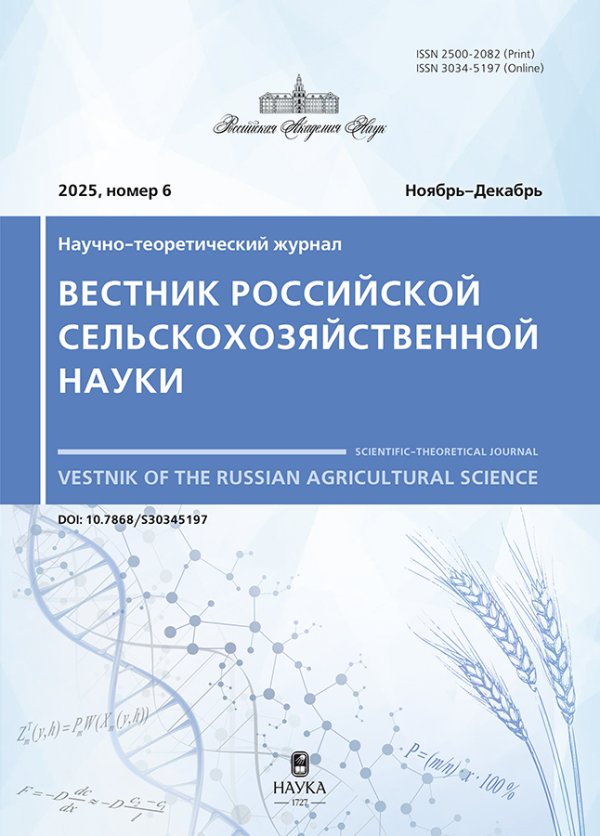Productivity and fatty acid composition of broiler chickens blood serum when fed bile
- Authors: Ryazantseva K.V1, Sizova E.A1, Nechitailo K.S1
-
Affiliations:
- Federal Research Centre of Biological Systems and Agrotechnologies of the Russian Academy of Sciences
- Issue: No 6 (2023)
- Pages: 87-90
- Section: Articles
- URL: https://journal-vniispk.ru/2500-2082/article/view/233589
- DOI: https://doi.org/10.31857/2500-2082/2023/6/87-90
- EDN: https://elibrary.ru/WQXHBD
- ID: 233589
Cite item
Full Text
Abstract
Keywords
About the authors
K. V Ryazantseva
Federal Research Centre of Biological Systems and Agrotechnologies of the Russian Academy of Sciences
Email: reger94@bk.ru
E. A Sizova
Federal Research Centre of Biological Systems and Agrotechnologies of the Russian Academy of Sciences
K. S Nechitailo
Federal Research Centre of Biological Systems and Agrotechnologies of the Russian Academy of Sciences
References
- Егоров И.А., Манукян В.А., Ленкова Т.Н. и др. Под общей редакцией академиков РАН В.И. Фисинина и И.А. Егорова. Руководство по кормлению сельскохозяйственной птицы. Методическое пособие. М.: ЛИКА, 2019. 215 с.
- Сизова Е.А., Рязанцева К.В. Жиры и эмульгаторы в кормлении цыплят-бройлеров (обзор) // Сельскохозяйственная биология. 2022. Т.№ 4(57). С. 664-680. doi: 10.15389/agrobiology.2022.4.664rus.
- Alzawqari M.H., Al-Baadani H.H., Alhidary I.B. et al. Effect of taurine and bile acid supplementation and their interaction on performance, serum components, ileal viscosity and carcass characteristics of broiler chickens // South African Journal of Animal Science. 2016. Vol.46. No.4. PP. 448-457.
- Bontempo V., Comi M., Jiang X.R. et al. Evaluation of a synthetic emulsifier product supplementation on broiler chicks // Animal Feed Science and Technology. 2018. Vol.240. PP. 157-164. doi: 10.1016/j.anifeedsci.2018.04.010
- Crespo N, Esteve-Garcia E. Polyunsaturated fatty acids reduce insulin and very low density lipoprotein levels in broiler chickens. Poultry Science. 2003. Vol.82. No.7. PP.1134-9.
- Fébel H., Mezes M., Palfy T. et al. Effect of dietary fatty acid pattern on growth, body fat composition and antioxidant parameters in broilers // Journal of Animal Physiology and Animal Nutrition. 2008. Vol.92. No.3. РР. 369-376. doi: 10.1111/j.1439-0396.2008.00803.x
- Ge X., Wang A., Ying Z. et al. Effects of diets with different energy and bile acids levels on growth performance and lipid metabolism in broilers // Poultry Sci., 2018. Vol. 98. PP. 887-895.
- Hofmann A.F., Hagey L.R. Bile acids: chemistry, pathochemistry, biology, pathobiology, and therapeutics // Cellular and molecular life sciences: CMLS. 2008. Vol.65. No.16. PP. 2461-2483. doi: 10.1007/s00018-008-7568-6
- Krasnodebska-Depta A., Koncicki A. Physiological values of selected serum biochemical indices in broiler chickens // Medycyna Weterynaryjna. 2000. Vol.56. PP. 456-460
- Lefebvre P., Cariou B., Lien F. et al. Role of bile acids and bile acid receptors in metabolic regulation // Physiological reviews. 2009. Vol. 89. No.1. PP. 147-191. doi: 10.1152/physrev.00010.2008
- Parsaie S., Shariatmadari F., Zamiri M.J., Khajeh K. Influence of wheat-based diets supplemented with xylanase, bile acid, and antibiotics on performance, digestive tract measurements, and gut morphology of broilers compared with a maize-based diet // British Poultry Scienceю 2007. Vol. 48. PP. 594-600.
- Poureslami R., Raes K., Turchini G.M. et al. Effect of diet, sex and age on fatty acid metabolism in broiler chickens: n-3 and n-6 PUFA // The British journal of nutrition. 2010. Vol.104. No.2. PP. 189-197. doi: 10.1017/S0007114510000395
- Van Le H., Nguyen D.V., Vu Nguyen Q. et al. Fatty acid profiles of muscle, liver, heart and kidney of Australian prime lambs fed different polyunsaturated fatty acids enriched pellets in a feedlot system // Scientific Reports. Vol.9. No.1. PP.1238. doi: 10.1038/s41598-018-37956-y
- Zaefarian F., Abdollahi M.R., Cowieson A., Ravindran V. Avian liver: the forgotten organ // Animals. 2019. Vol. 9. No. 2. PP. 63.
Supplementary files










